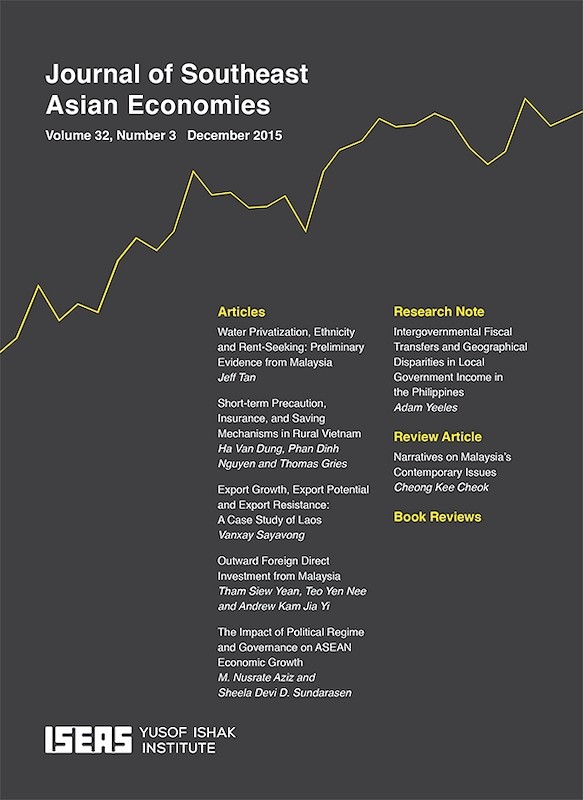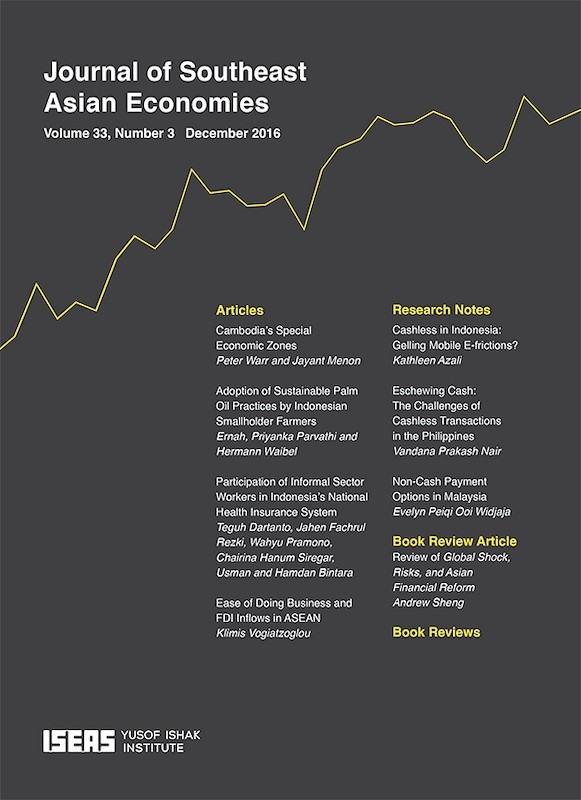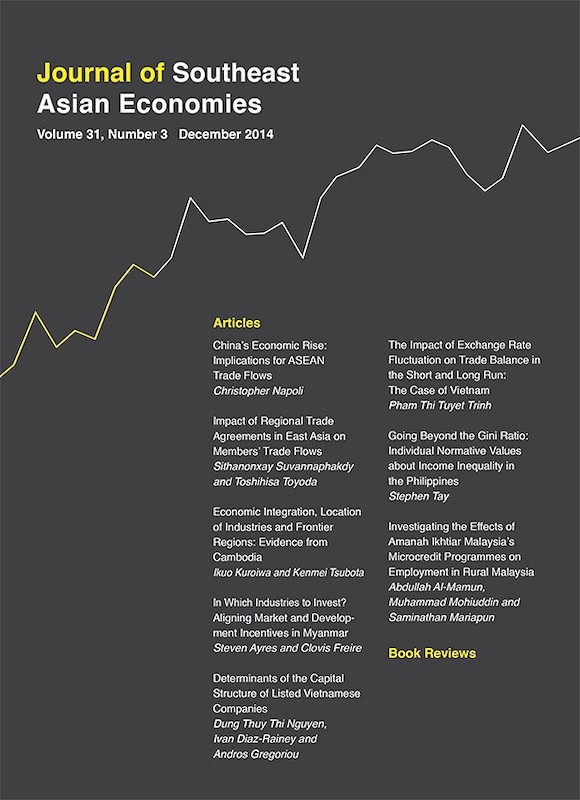ASEAN Economic Bulletin Vol. 19/3 (Dec 2002)

Date of publication:
January 2003
Number of pages:
128
Code:
AE19/3
Contents
-
ASEAN Economic Bulletin Vol. 19/3 (Dec 2002)
-
Preliminary Pages
- ARTICLES
-
Foreign Direct Investment and Poverty in the ASEAN Region, by Hossein Jalilian, John Weiss, authors see abstractWhile there have been general discussions on the possible direct and indirect effects of FDI on poverty, there are few formal quantitative tests of these propositions. This paper attempts to address this gap in the literature. We first consider a theoretical model and then examine data on a sample of countries to quantify the FDI-growth-poverty relation. At the very minimum our analysis has found no evidence that FDI either weakens growth or reduces the incomes of the poor. More positively, our econometric analysis finds that FDI inflows, particularly in the case of ASEAN, are associated with higher economic growth, and that there is a close relation between average income growth and growth of the income of the poor.
-
Performance Gains through Privatization and Competition of Asian Telecommunications, by Emilyn Cabanda, Mohamed Ariff, authors see abstractThis paper investigates the relative performance of three Asian telecommunication firms - Nippon Telegraph and Telephone Company (NTT), Telekom Malaysia (TM), and Philippine Long Distance Telephone Company (PLDT) - after the adoption of both privatization and competition reforms from the mid-1980s to the early 1990s. Privatization is justified as a restructuring method (change in ownership) to improve the accounting-cum-financial performance of state-owned and state-operated firms, which is distinct from competition or liberalization of an industry. Hence the maintained hypothesis is tested as to whether there have been improvements following privatization and introduction of competition. A number of findings relating to the pre- and post-restructured performance of these privatized firms are reported offering a comparison of accounting-cum-financial indicators of this industry over forty-two years in aggregate. Statistical tests on the tested pre- and post-values suggest statistically significant overall gains after privatization using this restructuring policy tool. However, the results show a relative decline in employment. Some aspects of performance also do not suggest efficiency gains.
-
Import Demand for Environmental Goods and Services in the Asia-Pacific Region, by Brock Avery, Fred O Boadu, authors see abstractThis paper estimates environmental goods and services (EGS) import demand elasticities for selected countries in the Asia-Pacific region. The paper employs a pooled cross-section and time-series estimation technique and makes per capita demand for EGS a function of economic, political, and structural factors in a country. The results show that improvements in incomes will lead to an increase in the demand for EGS. Also, the ongoing liberalization of markets in the region, especially tariff reductions will increase EGS demand. The high income elasticity of demand points to opportunities for in-country firms to explore domestic market niches.
-
Regional Disparity in Accessibility to Non-Farm Economic Involvement among Rural Indonesian Households, by Takayoshi Kusago, author see abstractIndonesia had achieved high economic growth in the late 1980s and the first half of the 1990s. Yet rural poverty is pervasive and widespread across the country. Recently the significance of rural non-farm economic activities has received much attention for stabilizing household income of the rural poor. This paper focuses on factors that influence rural Indonesian households accessibility to non-farm economic activities. It has tested the propensity of non-farm economic engagement among rural households by incorporating community and household characteristics. A simple econometric analysis with the country-wide sample has found that household demographic structure, educational attainment, rural infrastructure, agricultural technology, local market and geographical factors are the major determinants. However, the econometric analysis with five regional-based sub-samples have shown that main determinants are not the same as those found in the country-wide sample, and they do vary across the different regions. This paper suggests that it is very important to understand region-specific household and community characteristics in order to design effective development policy tools and to have more viable non-farm economic activities in rural Indonesia.
-
Trade Liberalization and Foreign Direct Investment in Vietnam, by Nguyen Nhu Binh, Jonathan Haughton, authors see abstractThis paper estimates the effects of the bilateral trade agreement (BTA) between the United States and Vietnam, which came into effect in December 2001, on foreign direct investment (FDI) in Vietnam. The effects are simulated using the results of an econometric model of the determinants of FDI, which is estimated in reduced form using data from sixteen Asian countries from 1990 to 1999. The BTA should lead to 30 per cent more FDI into Vietnam in the first year, and an eventual doubling of the flow. This would boost economic growth by 0.6 percentage points annually. However the inflow would only be maintained if Vietnam makes the changes required to join the World Trade Organization (WTO) by about 2005.
-
Board Remuneration, Company Performance, and Ownership Concentration: Evidence from Publicly Listed Malaysian Companies, by Ergun Dogan, Russell Smyth, authors see abstractThe determinants of executive compensation is hotly debated in Malaysia and elsewhere in Asia. Drawing on the approach used in previous studies for the United Kingdom and United States as well as other countries, this study examines the determinants of board compensation in Malaysian companies listed on the Kuala Lumpur Stock Exchange over the period 1989-2000. We find evidence of a statistically significant positive relationship between board remuneration and sales turnover and a statistically significant negative relationship between board remuneration and ownership concentration. However, the relationship between board remuneration and firm performance is ambiguous, while there is no evidence of a significant relationship between board remuneration and sector performance.
-
BOOK REVIEW: Inside Japanese Business: A Narrative History: 1960-2000, by Makoto Ohtsu with Tomio Imanari, by Mitsuru Mizuno, author
-
BOOK REVIEW: Managing Korean Business: Organization, Culture, Human Resources and Change, edited by Chris Rowley, Tae-Won Sohn, and Johngseok Bae, by Yong-Joo Lee, author
-
BOOK REVIEW: A Zone of Asian Monetary Stability, by Tetsuji Murase, by Pamela Mar, author
-
BOOK REVIEW: Regional Integration and Economic Development, edited by Neantro Saavedra-Rivano, Akio Hosono, and Barbara Stallings, by Masaru Umemoto, author
-
BOOK REVIEW: Americas Trade Follies: Turning Economic Leadership into Strategic Weakness, by Bernard K. Gordon, by Michael G Plummer, author





